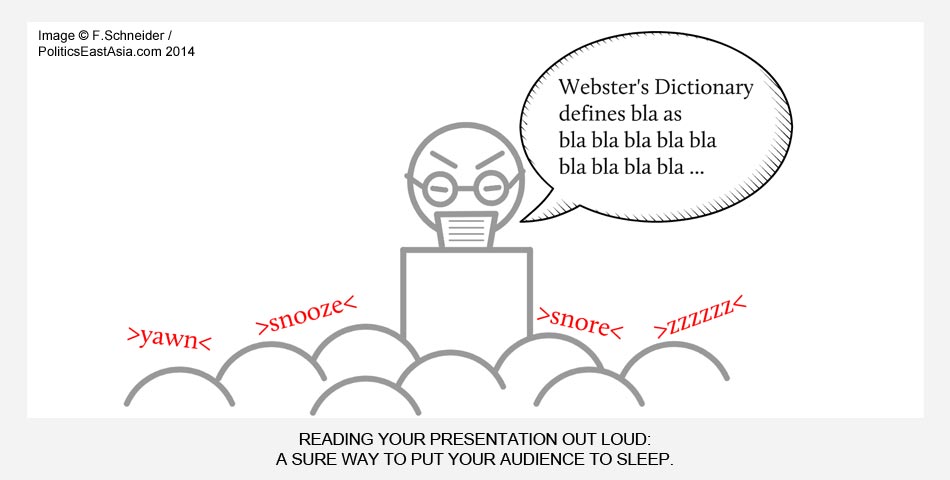Five Ways to Do a Good Presentation
…and why reading your presentation out loud is not one of them.
Have you ever been to a conference, a lecture, or a workshop where the presenter read their presentation to you? Sadly, for most academics, this is a common occurrence: presenters walk up to the podium, take out their research paper or script, and then monotonously drone their way through it. An alternative is to throw up slide after slide of bullet points and then read those to the audience (…what writer Charles Stross calls “death by PowerPoint”).
There are of course cases where speakers excel at reading out written texts or presenting carefully scripted narratives – many of the world’s great speeches were held this way – but it is exceedingly rare to find yourself in the presence of such a gifted individual. Unless you happen to be Stephen Fry or Morgan Freeman, reading a text out loud to an audience has one effect only: making the listeners zone out. Your audience does not want to hear you read to them. Whether they are your teachers, your peers, or your students, they can always read your work in their own good time. When they show up for your presentation, they want to hear you speak about your subject. They want to be enthused. They want to be engaged. And yes: they want to be entertained.
I sometimes get told that there are good reasons for reading out a presentation. For example, if you are not a native speaker, it can be punishing to have to talk for a sustained amount of time, especially on an academic or otherwise professional topic. Similarly, for anyone who suffers anxieties of public speaking, having a scripted text may be the only thing standing between them and a nervous breakdown. And then there are places where reading presentations out loud is part of a particular culture – certain sectors of Chinese or German academia come to mind.
Personally, I find that none of these examples make a convincing case for the death-by-boredom that is the publicly read lecture. A written text is a crutch, and your audience knows it. If you are presenting in a foreign language, you need to of course prepare. But if you think your audience will understand you better because you are reading a prepared text, then you are kidding yourself. In my experience, the opposite is the case: the written texts tend to be so far removed from naturally spoken language that they are difficult or impossible to follow. If anything, a freely presented talk will be much more successful in a foreign language, even if it is full of mistakes. That’s because freely spoken presentations engage your audience directly, which means people will listen to you differently. And yes: they will forgive you for not speaking the language perfectly, because they can tell you made a real effort at talking to them. Awkwardly read, artificially constructed sentences do not achieve this.
The same is true for texts read by people with clear and obvious performance anxiety. One of the greatest worries for anyone who dreads public speaking is that they will get up on the stage and forget what they were trying to say. Having a text written out seems like an appropriate security measure, but it actually makes the situation worse. Have you ever felt awkward for someone because they were so nervous in public? A written text does not change this. To the contrary: the audience is likely to feel even more awkward for someone who is labouring through their talk by looking down at a script and quietly (and maybe quickly) mumbling their text.
Mark Twain is often quoted to have said: “There are two types of speakers. Those who get nervous and those who are liars”. I believe he is entirely right. I know I dreaded public speaking when I was in high school, and I only got better at it by desensitizing myself to the feeling of being on a stage. I took up every opportunity I could find to speak in public. Nevertheless, I still get nervous to this day. There are two crucial ways I deal with this. The first is to prepare thoroughly, until I am confident about what I want to say. The second is to connect, at a personal level, with the people I am speaking to – through eye-contact, by asking them questions, by joking with them, by using body-language to open up to them, or even by honestly telling them that I am nervous today.
Reading a text arguably ticks the box for “preparedness”, but it gets in the way of connecting with people. If you engage your audience freely in your natural way of speaking, you are much more likely to get them on your side.
So what about established “cultures” of reading out presentations, and the expectations that such “cultures” create? Well, cultures can change. Dare to defy expectations and surprise your audience. Throw away your PowerPoint slides and do something different. Your listeners will reward you with their attention and their gratitude.
In short: lacking language skills, fear of public speaking, or well-established traditions are no excuse for reading a presentation out loud, or for making your audience suffer boring slides full of bullet points. But what are the alternatives? What can you do to truly jazz up your talk?
Here are five of my favourite strategies:
1. Draw your argument.
Think about what your argument would look like if you had to draw it on the back of a napkin. What is the essence of what you have to say? Then walk up to a white board (or black board, or flip chart) and explain your topic while you draw it. Are you talking about an event? Draw stick figures. Are you talking about a place? Draw a map. Are you talking about a process? Draw a flow chart. None of this has to be pretty. In fact, if you draw badly, just have a laugh together with your audience. Nothing lightens the mood and endears you to your audience like showing that you are only human. Vulnerability can be a strength.
2. Show your audience one picture or one key word.
Fill the screen with an image that links to your topic. This could be the photo of an important person, an image of a particular event, or even something whimsical like a comic. If it allows you to tell a story, an image like this can be an immensely powerful tool to draw your audience in. What is more, it serves as an important mnemonic cue, making it easier for your audience to remember your talk. If you don’t have an image, or if your talk is more conceptual, you can also throw one single work onto the screen – something essential to your argument – and then talk about that. Just try to avoid clichés. Buzzwords like “synergy” or “actionability” are probably not your best choice…
3. Bring an object.
Show-and-tell can be a great way to discuss an issue. Whether you are an anthropologist who works on material culture, a historian who analyses ancient tomes, a political scientist who studies voting behaviour, or an economist who studies consumption patterns, show your audience a crucial object that ties in with your work. Let them take a first-hand look at that sewing machine, or that handwritten manuscript, or that election ballot, or that Hello-Kitty mobile phone that kicked off your interest in the topic. What got you enthusiastic when you started your work? Chances are it will draw your audience in as well.
4. Mind-map your work.
I love the presentation software Prezi. It allows you to put all of your materials and ideas on a blank canvas, arrange them in a way that makes sense, and then walk your audience through that canvas. It takes some time to get used to the program and its features, and there are certain things you should be careful to avoid (like shifting and turning the camera so much that your audience gets motion sick), but with a little bit of practice you can create lively, engaging visuals that you can present either from a browsers or a USB stick. Also, it’s free.
5. Perform your argument.
Do you have artistic skills? Are you a musician? A dancer? Well go ahead and dance your argument. Sounds crazy? Take a look at the winners of the annual science dance contest to get an impression of what is possible, or follow John Bohannon’s TED performance to see what I mean. Sure, it’s quirky, it’s wacky, it’s a bit insane. Most importantly, though: it’s creative. And it certainly beats putting your audience to sleep by reading PowerPoints to them.
If you want to read more about how to make engaging visuals to support your argument, take a look at my post on putting together good Prezi presentations.
Do you have a favourite way of presenting? Is there a tool or a strategy that really gets your audience engaged? Then share your experience and your tips with us in the comments section.
Share This Post, Choose Your Platform!
3 Comments
Comments are closed.



Great article. In the first sentence you could easily add ‘NGO-forum’ or ‘International summit’. but even when reading out a prepared statement, some performance or clear mind-map friendly structure of the speech can go a long way! thanks for these tips.
Thanks Thomas. I’m not sure whether it is comforting or shocking that bad presentations are not just a problem in academia… At any rate, I’m glad you found these tips useful.
[…] I shared my recent blog post on how to do a good presentation, I’ve received several questions on how I make the “snazzy” Prezi slides I use […]